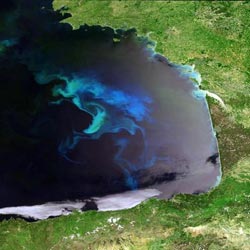Orientation of plancton effects the Oceans climate. Up to now scattering of light not sufficiently

Plankton bloom (Bay of Biscay on the Atlantic Ocean). Satellite: Envisat-MERIS.<br>Credit: European Space Agency (ESA) http://earth.eo.esa.int/cgi-bin/satimgsql.pl?show_url=4&startframe=0<br>
An international research team including Prof. Andreas Macke, Director of the Leibniz-Institute for Tropospheric Research, explained this optical phenomenon now.
In a paper of the renomated science journal “Proceedings of the National Acadamy of Sciences” (PNAS) the researcher report that the typically elongated shaped bacteria get aligned in regions of largest shear of the fluid which in turn provides a stronger scattering into the forward and backward direction compared to randomly oriented particles. This orientation effect generally holds for plankton in the most upper ocean layer and would lead to a larger penetration depth of sunlight than predicted by previous models.
Wind stress at the ocean surface produces a vertical shear in which the elongated phyto plancton particles and bacteria become oriented. In case of natural microbial assemblages moderate shear velocities can increase the back (and forward) scattering of the incident light by 20%. During phyto-plankton blooms already small velocities can change scattering by more than 30%. A larger penetration depth of solar radiation would have consequences on photosynthesis rates, primary production and thus the CO2-uptake of the ocean. The study reveals a subtle interplay between fluid dynamics, ocean biology and ocean optics. “These results proof that biophysical interactions on the microscale can play an essential role on global scale marine processes,” Andreas Macke explained.
The orientation-induced change of the light transmissivity also leads to a change in the reflected sun light. The latter effects the satellite based remote sensing of plankton concentrations in the world oceans so that correction of the previously retrieved plankton loads might become necessary. Macke has demonstrated similar orientation effects for ice crystals in troposheric cirrus clouds.
Publication:
Marcos, Justin R. Seymour, Mitul Luhar, William M. Durham, James G. Mitchell, Andreas Macke and Roman Stocker (2011): Microbial alignment in flow changes ocean light climate. PNAS. March 8, 2011. vol. 108 no. 10 3860-3864
http://dx.doi.org/10.1073/pnas.1014576108
This work was supported in part by Australian Research Council (ARC), by the Massachusetts Institute of Technology (MIT) and by the National Science Foundation (NSF).
Klotzsche, S.; Macke, A. (2006): Influence of crystal tilt on solar irradiance of cirrus clouds. Applied Optics 45(5), 1034-1040
http://dx.doi.org/10.1364/AO.45.001034
More Infos:
Prof. Andreas Macke
Leibniz-Institute for Tropospheric Research (IfT)
Tel. +49-341-235-3210
http://www.tropos.de/ift_personal.html
Video:
http://www.pnas.org/content/suppl/2011/02/18/1014576108.DCSupplemental/sm01.mov
Media Contact
All latest news from the category: Earth Sciences
Earth Sciences (also referred to as Geosciences), which deals with basic issues surrounding our planet, plays a vital role in the area of energy and raw materials supply.
Earth Sciences comprises subjects such as geology, geography, geological informatics, paleontology, mineralogy, petrography, crystallography, geophysics, geodesy, glaciology, cartography, photogrammetry, meteorology and seismology, early-warning systems, earthquake research and polar research.
Newest articles

Properties of new materials for microchips
… can now be measured well. Reseachers of Delft University of Technology demonstrated measuring performance properties of ultrathin silicon membranes. Making ever smaller and more powerful chips requires new ultrathin…

Floating solar’s potential
… to support sustainable development by addressing climate, water, and energy goals holistically. A new study published this week in Nature Energy raises the potential for floating solar photovoltaics (FPV)…

Skyrmions move at record speeds
… a step towards the computing of the future. An international research team led by scientists from the CNRS1 has discovered that the magnetic nanobubbles2 known as skyrmions can be…




















